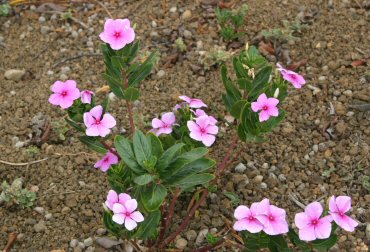The pretty pink flower that has the power to heal!

Making the move!
-ADAPTATIONS-
How have plants adapted to life on land? The earliest ancestor of plants, suggests that all land plants derived from a single ancestral green algae. Transitioning from life in the water, to life on land, required some pretty interesting changes. The first plants were non-vascular meaning that they lacked the vascular tissues of xylem and phloem that are used for internal transport of materials. Secondly, the move from water to land led to a waxy cuticle on the leaves, which contain stomata, to protect from desiccation. The leaves increased photosynthetic surface area. Roots were also developed for better support so plants could anchor themselves to the ground and further allow for the uptake of the nutrients such as water from their surrounding environment.
 The Periwinkle of Madagascar is a vascular seed
plant that has xylem, and phloem. It prefers a warm tropical
climate but has adapted to a mild climate as well. Thus, Catharanthus roseus
has adapted to a variety of soils, including soils of high moisture, to
soils that are slightly acidic. The periwinkle has thick glossy leaves
that provide a decent amount of ground cover.
The Periwinkle of Madagascar is a vascular seed
plant that has xylem, and phloem. It prefers a warm tropical
climate but has adapted to a mild climate as well. Thus, Catharanthus roseus
has adapted to a variety of soils, including soils of high moisture, to
soils that are slightly acidic. The periwinkle has thick glossy leaves
that provide a decent amount of ground cover.
*Photo above: A patch of Madagascar Periwinkles. Photo courtesy of Les Smith.
A perennial plant that blossoms every year, enjoys being in areas under partial sunlight, thus resulting in a growth of around 32 inches, or 80 cm in height. Another very significant piece of information about C. roseus is that they contain substantial amounts of alkaloids, that are potent to animals, but when extracted have great medicinal value for humans.
The unbelievable amounts of alkaloids produced by the periwinkles are the reason why they aid in the cure of Hodgkin's disease and leukemia because they contain great amounts of vinblastine and vincristine. Both of these drugs are what gives C. roseus their medicinal value. The alkaloids tend to be very potent and therefore, the white-tailed deer often times as well as insects tend to avoid the periwinkles, and instead, feast on other plants.
Now that you have a better understanding of the adaptations, it's time to learn all about the NUTRITION of the Rosy Periwinkle.
Return Home
*Photo above: Courtesy of
Forest
& Kim Starr, biolib.cz
